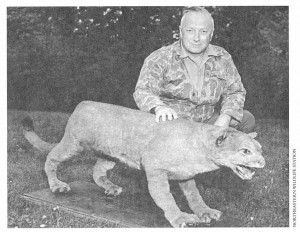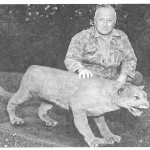MPBN Tackles The Eastern Cougar
Posted by: Loren Coleman on January 9th, 2012

Photo: Biologist Bruce S. Wright with the mounted specimen of what is believed to be the last eastern cougar, which was trapped in Maine in 1938. Courtesy U.S . Fish and Wildlife Service.
Maine Public Television Network (MPTN) came visiting the International Cryptozoology Museum today. Apparently, they are running a special next week on the status of the eastern cougar in Maine. They had been to interview the feds and the state folks. It was time to talk to someone who has investigated lots of firsthand encounters with the “impossible” cat, the well-seen mountain lion of Maine.

Susan Kimball, a known veteran of television broadcasting for over 20 years, trekked to the museum, and even allowed me to take her picture in front of our Bigfoot. She’s neutral on the subject, of course, as a reporter, but like lots of people in the state, including our state wildlife people, the discovery of some last stands of eastern puma here would be exciting.

Susan’s cameraman, Chris, also strikes a pose.
One of the most remarkable things she repeated to me from the wildlife authorities was the comment that there could be no cougars in the state because there’s not enough deer here for them to eat. They reportedly said that the mountain lion, even a small population, just could not survive on the number of deer here.
What?
According to statistics on the State of Maine’s own wildlife management page, the deer population in Maine certainly is not endangered. It may not be as high as it was when 275,000 deer wintered in Maine in the late 1950s. But there are lots of deer out there. The deer are mostly hunted by humans, of course, but there are plenty left over. As one government website notes: “Each year, thousands of hunters take to the deer woods in Maine. Hunters averaged 150,000 during the 1950’s, then increased to a peak of 215,000 by 1982. During the early 1980’s, deer hunters outnumbered their prey in Maine! Since that time, hunters’ ranks have steadily diminished, reaching a modern low of 178,000 in 1997. Hunting success rate was highest during the 1950’s, averaging nearly 25%, overall.”
“Since the early 1980’s, the population has increased to 255,000 wintering deer.”
Mountain lion researchers have found that a healthy puma may kill one deer every 9 to 14 days in the temperate colder areas, and as many as 2 per week in hot climates. Taking 50% of the known deer out of the equation for hunters (too high a number but I’m making a point here), and taking another 25% out because of the deer being too healthy for pumas to catch, let’s say there are about 60,000 deer left for cougars to eat in Maine. Taking the total high number needed per week per cat (104 deer per year for one felid) for the hot climates, that means the State of Maine could host a population of 577 mountain lions, if they were just eating deer.
But as I noted to Susan Kimball, mountain lions have been known to survive on small mammals and grasshoppers for long periods of time. Sorry, I don’t think the “lack of deer” in Maine, which is not a correct statement, is a good reason to say there are no cougars in the state.
+++
Update: Susan Kimball, when made aware of this research, said she made a mistake in recalling her notes and had transported thoughts from an article about a biologist telling what it takes to keep a cougar alive to the interviews she had being doing in Maine. She appreciated me bringing this to her attention so she could be correct in her forthcoming story. She wrote: “I don’t want my careless mistake to reflect badly on Maine’s game wardens.”
The scripted program will not reflect the deer data.

Do the eastern pumas exist in Maine? Stay tuned. I’ll let you know when the broadcast is set for next week.
About Loren Coleman
Loren Coleman is one of the world’s leading cryptozoologists, some say “the” leading living cryptozoologist. Certainly, he is acknowledged as the current living American researcher and writer who has most popularized cryptozoology in the late 20th and early 21st centuries.
Starting his fieldwork and investigations in 1960, after traveling and trekking extensively in pursuit of cryptozoological mysteries, Coleman began writing to share his experiences in 1969. An honorary member of Ivan T. Sanderson’s Society for the Investigation of the Unexplained in the 1970s, Coleman has been bestowed with similar honorary memberships of the North Idaho College Cryptozoology Club in 1983, and in subsequent years, that of the British Columbia Scientific Cryptozoology Club, CryptoSafari International, and other international organizations. He was also a Life Member and Benefactor of the International Society of Cryptozoology (now-defunct).
Loren Coleman’s daily blog, as a member of the Cryptomundo Team, served as an ongoing avenue of communication for the ever-growing body of cryptozoo news from 2005 through 2013. He returned as an infrequent contributor beginning Halloween week of 2015.
Coleman is the founder in 2003, and current director of the International Cryptozoology Museum in Portland, Maine.










I don’t need to wait… Myself and a Suburban-load of visiting relatives had one cross the road in front of us just outside Holden, ME on 1A, headed to Ellsworth, ME.
There is no doubt what it was. It crossed the road in front of us, and stood in someone’s dooryard and watched us as we drove past.
I sometimes wonder if IFW isn’t just trying to protect an obviously small population.
But to say they’re not here is just not true.
And once again, one of the least-tenable of skeptical canards: there’s not enough for them to eat.
There is a very basic, and very fatal, scientific misstep behind this lulu: IT PRESUMES THAT THE ANIMAL ISN’T THERE. Trust me. You can’t reason it any other way. Go ahead. Try it. Put it up here if you dare.
And never mind Loren’s demonstration that there is plenty.
Of course there are Eastern Cougars.
I live in recognized cougar range in the West, but have worked a great deal in the East and Southeast. And I’ve seen cougars in places they are not “supposed to” exist.
The problem is not a lack of cougars or prey animals. The problem is they would impose a financial burden on the states that do not claim to have them, if they were acknowledged to be a resident population. That would require plans and actions to “manage” them. And make their protection a consideration in environmental impact studies.
So myths are created to explain away reality.
The Eastern Cougars that keep turning up cannot be dismissed as someone’s imagination. Too much physical evidence exists, including dead specimens and videos.
So the myths appear: the animals are escaped pets. Or, they have made epic journeys from places like South Dakota’s Black Hills. Too bad there are no more circus trains to escape from.
You know, here in AZ, trap cameras finally captured a cougar and no one thought they were in our state at all. When it comes to cats, they are very stealthy. I would not be surprised if Maine had them. That whole NE corridor seems like an environment that would provide plenty of incentive for such wildlife.
I’m just wondering, is there a possibility that eastern cougars really are extinct, but western cougars are just moving in?
Autumn,
Of course you have cougars in Arizona. And jaguars and ocelots, too.
When I was working in SW NM, I saw cougars and a coatimundi. I worked with people who had seen jaguars in the same area.
Trail cams in Arizona regularly record cougars. Jaguars and ocelots less often, but are there.
Airgunner you make an interesting point but it go both ways. Here in ohio the DNR is apparently importing cougars to control deer populations because there are to many insurance claims from deer/vehicle accidents and they are dropping timber rattlers from helicopters in water balloons. I’m inclined to go with Kittalias theory.
As for deer when I lived outside Waterville Maine in the late 90’s we would go out spotlighting at night(not during deer season all legal beagle) and it would not be uncommon to count over 100 deer in a few hours.If I remember correctly the deer density for that county at that time was just above 30 deer per sq mile its probably gone up since then.
Kittalia:
It is possible that the eastern cougar is extinct, although I think that the recent pronouncement to that effect may have been premature, particularly during a period of increase in sightings.
I believe that the primary theory behind the surge in cougar sightings in areas where the eastern cougar formerly lived is that western cougars are indeed moving east to seek new range. Cougars have big territories. If they aren’t hunted, this is inevitable, sooner or later. And coyotes have shown that it can happen even if they are hunted.
My sister was at an elementary school in Westbrook (DON’T ASK!) when she saw a large, catlike shape walk into the woods right nearby. That’s enough to me.